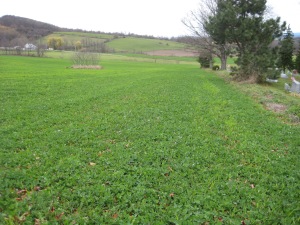It’s November. Not a doubt of it. I can tell, because of all the usual clues.
I can see my breath. There’s a skim of ice on the pond. I need mittens in the morning, because the steering wheel is like ice. The trees have bare branches.
And the grass is emerald green.
It’s the oddest thing about November, I find, the combination of brown shrivelled flowers, barren tree branches, and bright green grass.
Grass, you see, is hard to kill. The leaves of many species of grass and lots of other low-lying plants, like clover, are highly resistant to frost. It’s hugely to the plants’ advantage, of course, that the leaves stay green as long as possible. If they’re green, they’re filled with chlorophyll, churning away at photosynthesis and maximizing food production. Many plants can photsynthesize even when the temperature is below freezing.
That’s because they are able to create a protein that functions like the antifreeze in your car. It disrupts the formation of ice crystals and lowers the freezing temperature of the fluids in the leaf.
Every leaf is made up of cells. If it gets cold enough, the water that fills the leaf between the cells will freeze. But as long as the actual cells don’t freeze, the leaf lives on. Photosynthesis continues. Some plants, of course stay green even under the snow. An insulating and hydrating blanket of snow can keep grass green all winter.
But if the temperature drops so low that the fluid inside the cells freezes, that’s it. The leaf is dead. Brown grass. But of course the grasses and the clovers live on, as a dense network of roots under the soil. Biding their time till spring.





Me gustaría saber el nombre de la planta que tiene por segunda imagen. Es muy bonita y me encanta la combinación de tonos de verde que tiene. Mi correo es [email protected]
Espero su respuesta. Gracias